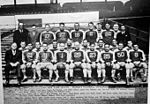555 Edgecombe Avenue

The Paul Robeson Residence, also known by its street address of 555 Edgecombe Avenue, is a National Historic Landmarked apartment building, located at 555 Edgecombe Avenue at the corner of West 160th Street in the Washington Heights neighborhood of Manhattan, New York City. It was originally known as the "Roger Morris" when it was built in 1914-16 – after the retired British Army officer who built the nearby Morris-Jumel Mansion – and was designed by Schwartz & Gross, who specialized in apartment buildings. The building is architecturally relatively non-descript, with an exterior of brick and stone with nods to Beaux Arts architectural elements. It has thirteen floors and a penthouse. The main entrance is two stories in height, set in an arched opening with ironwork at the peak.For the first 25 years of its existence, the building was restricted to white tenants. Around 1940, as the racial characteristics of the neighborhood changed, this policy was dropped. Subsequently, the building became known for the noted African-American residents, including musician and composer Count Basie, boxer Joe Louis, musician Bruce Langhorne, musician and bandleader Andy Kirk, actor and producer Canada Lee, the psychologist Kenneth Clark, and the actor and singer Paul Robeson, a major figure of stage and screen who lived in the building from 1939 to 1941.After Robeson's death in 1976, the building was declared a National Historic Landmark in his honor. In 1993, it was designated a New York City landmark. Edgecombe Avenue has also been co-named "Paul Robeson Boulevard".
Excerpt from the Wikipedia article 555 Edgecombe Avenue (License: CC BY-SA 3.0, Authors, Images).555 Edgecombe Avenue
Edgecombe Avenue, New York Manhattan
Geographical coordinates (GPS) Address External links Nearby Places Show on map
Geographical coordinates (GPS)
| Latitude | Longitude |
|---|---|
| N 40.833888888889 ° | E -73.938888888889 ° |
Address
Paul Robeson Residence (555 Edgecombe Avenue)
Edgecombe Avenue 555
10032 New York, Manhattan
New York, United States
Open on Google Maps








